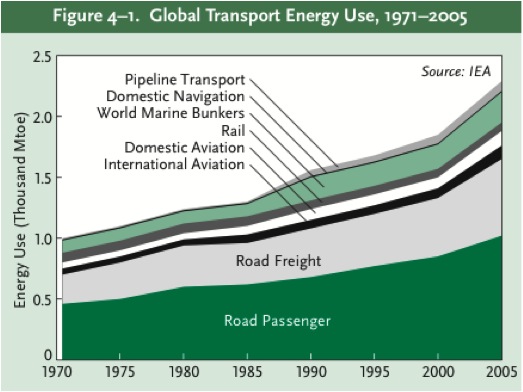
If you think the United States is doing a bad job shifting toward sustainable transportation, take a look at the developing world. The places with the most to lose from auto-oriented development are doubling down on it -- to the enormous detriment of their citizens, especially the poorest.
The number of cars in the world is expect to grow as much as 375 percent by 2050. Road fatalities in low- and middle-income countries are expected to rise by 80 percent just over the next eight years, with pedestrians, cyclists, and other vulnerable users making up about half those deaths. Harmful air pollutants that already cause 1.3 million premature deaths each year, mostly in developing and middle-income countries, will rise. And carbon dioxide emissions from transport could grow 300 percent over 2005 levels by 2050 -- with most of the growth, again, coming from the developing world.
Michael Replogle and Colin Hughes warn of these dire outcomes in their article on sustainable transportation for the 2012 State of the World report, published by the Worldwatch Institute. While international climate change agreements have historically overlooked the transportation sector, the authors note some promising changes afoot as international development banks seek to add transit projects to their portfolios.
Replogle and Hughes frame transportation policy in terms of both sustainability and equity. The urban poor lose out disproportionately when car-oriented infrastructure dominates, they note, since the lack of affordable transportation forces them "to choose between low incomes in informal sector employment close to affordable housing and higher-wage jobs that force them to spend a large share of their income and hours each day commuting."
Compounding the inequity, fossil fuel subsidies disproportionately allocate public funds to the wealthy, the authors report: “The International Energy Agency estimates that only eight percent of the $409 billion that the world spent in 2010 to subsidize fossil fuel consumption (about half of which is used for transport) went to the poorest 20 percent of the population.”
Unfortunately, say Replogle and Hughes, international agreements on poverty reduction and climate change have largely ignored transportation. Even the Agenda 21 agreement, a bogeyman among far-right cranks, included "no targets, goals, commitments, or other forms of accountability" for sustainable transport.
The Kyoto Protocol, adopted by 191 countries (but not the U.S.) and tasked with reducing greenhouse gas emissions by five percent by this year, didn’t specifically mention transportation – despite the fact that the transportation sector accounts for 27 percent of worldwide energy-related GHGs.
Key climate finance mechanisms like the Global Environmental Facility (GEF) and the Clean Development Mechanism (CDM) have generally avoided transportation too, because it requires more difficult accounting. Given the fact that transportation is now the fastest-growing source of emissions, with GHGs expected to increase by 250 percent by 2050, you’d think climate-minded institutions would pay more attention.
In the developing world, the rise of "Nationally Appropriate Mitigation Actions" -- voluntary commitments from individual countries to reduce GHGs -- holds more potential for transportation reform. Replogle and Hughes call NAMAs a "bottom-up approach" and “the most promising pathway to sustainability.” They say 28 of the 44 NAMAs submitted to the UN as of May 2011 specifically refer to emissions mitigation in the transport sector.
The authors point to solutions from around the world that could help reduce transportation costs, lower emissions, and improve service. In Singapore, vehicle registration quotas are allocated through auction. Several European cities charge congestion fees for driving at rush hour. Bus Rapid Transit has reduced emissions and traffic fatalities in Ahmedabad, Bogotá, Guangzhou, and Eugene, Oregon. Public bike systems around the world have increased cycling. Parking management and pricing in Europe, Asia, and the U.S. reduce subsidies for inefficient modes.
International financing institutions are beginning to catch on. The GEF is increasing its transportation portfolio. And the five major multilateral development banks, which have historically invested almost exclusively in road-building, have been putting about ten percent of their transportation investments toward sustainable modes – a shift that’s expected to continue. The Asian Development Bank, specifically, has set a target of investing 30 percent of its transport portfolio in urban transport and 20 percent in rail by 2020 -- while reducing road investment to about 42 percent of its portfolio. Several banks have hired more urban transport and rail specialists, rather than traditional road engineers, according to the authors, and are paying more attention to emissions impacts.
Since the Worldwatch report was published in April, the Rio+20 Conference on Sustainable Development made big news on the sustainable transportation front. The largest financial commitment made at that summit was a pledge by the eight largest multilateral development banks to commit 500 staff and dedicate $175 billion for more sustainable transportation in the coming decade. Done right, Replogle says, the fresh attention and sizable investment of these institutions could bring about a “paradigm shift” in how transportation is conceived and paid for.






